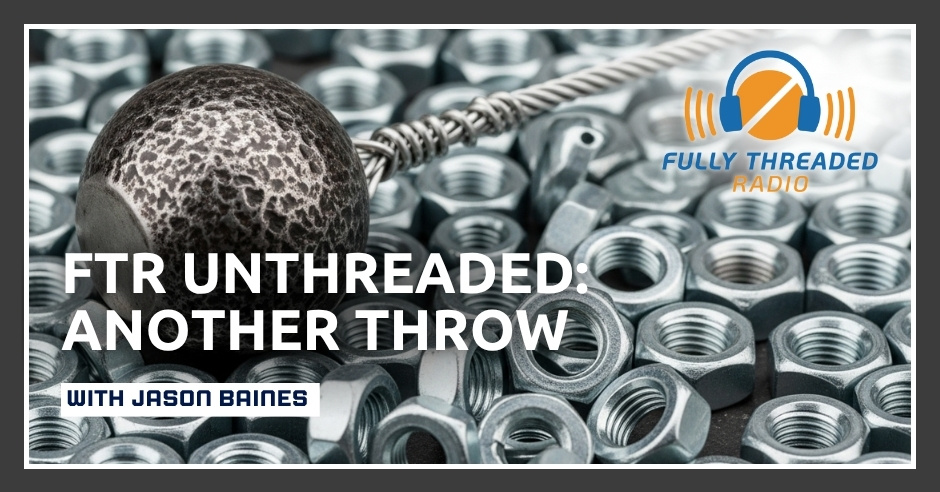
With tariff talk deadlines looming, Canadian locknut provider J. Lanfranco VP and part-time Highlander Jason Baines provides an update on where things stand. He also explains his entry into the realm of Scottish hammer throwing, how Canada could address some of its challenges right now, and the therapeutic aspect of raising chickens. Run time: 39:08
—
Listen to the podcast here
Important Links
- J. Lanfranco
- Jason Baines on LinkedIn
- Special Report: A Canadian Perspective on Tariffs with Jason Baines
FTR Unthreaded: Another Throw With Jason Baines
This one is a conversation with Jason Baines of J.Lanfranco, well known in the industry for mission-critical bolting solutions. They’re based in Canada, but their footprint extends across the US as well. This discussion is a follow-up to our previous episode that we released later in March 2025, when the whole tariff situation was unfolding. It’s an update.
Jason provides a very thoughtful commentary on where things sit. This is ahead of a few negotiation deadlines that are happening. This is relevant information if you buy yourself fasteners in North America. Plus, we also have a little fun. You’ll get to read a little bit about Jason’s surprising athletic abilities, which I’m sure most people don’t know about, plus his three big regrets in life. This is a good conversation. You’re going to enjoy it.
J.Lanfranco has been a big supporter of Fully Threaded Radio for a long time, along with the title sponsors of Fully Threaded Radio, which are Brighton-Best International, Goebel Fasteners, and Star Stainless. Fully Threaded Radio is also sponsored by Buckeye Fasteners, BTM Manufacturing, Cresa, Eurolink Fastener Supply Service, Endries International, INxSQL Software, the International Fastener Expo, J.Lanfranco, MW Components, Solution Industries, Volt Industrial Plastics, and Würth Industry USA.
I’m recording this at the very end of July 2025. It’s sizzling hot here in semi-rural northeast Ohio. It is a good day to sit in a nice, cool office. Hopefully, that’s where you’re checking this out, but wherever you are, I appreciate you tuning in. Reach out if you have comments. The email address is FTR@FullyThreaded.com. Here’s my conversation with Jason Baines of J.Lanfranco.
‐‐‐
Jason Baines, it’s good to see you.
It’s great to be seen.
Why Jason Is Skipping The Tough Mudder (Again)
Here we sit, both bespectacled. We talked last time at the end of March. It was like a gut punch. We were all sitting here, saying, “Is this happening?” at the time. It’s hard to believe how much the world has changed in those few short months. We want to touch on that. Before we get to that, I also want to say that I noticed the Tough Mudder list of contestants came out. I keep trying to get you involved every year. Your name’s not on it again. Come on.
It’s one of the great regrets in my life. I have three great regrets. One was never learning to play the piano. Two was never writing my novel. In a close third is not doing the Tough Mudder with you. Many apologies. I love the area, and I love getting out there, but it always conflicts with the Highland Games every year. I’m still a sucker for when people want to pay me money to come up and toss hammers and logs in a field.
A little bit of a tell here. The good news is, with those three regrets, they can all be rectified because you’re still a young, strong guy. Don’t give up on those. I know you know that. I set it up this way because I don’t think a lot of people realize what a mega athlete you are or have been. With that whole Highland game thing, it’s astounding what you do. Lay that out for us.
It has become almost like a lifestyle. For most of the guys in the Highland Games, it’s a lifestyle. We mostly have kids, families, and full-time jobs. For those who don’t know you, you have your Highland games, and within them, the heavy events. Those are the guys who throw the Scottish hammers and toss stones. You’ve got the world-famous caber toss.
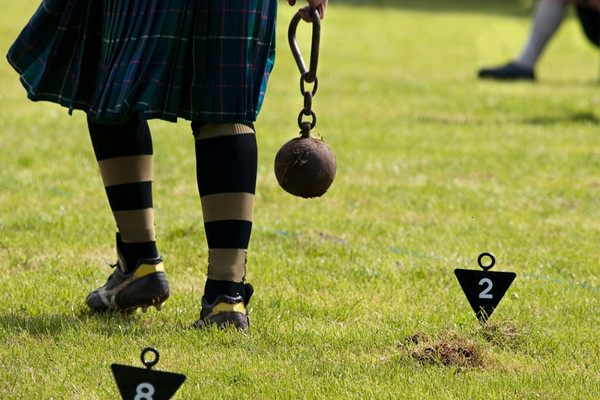
I was a track and field athlete. I started very late doing Olympic-style hammer throwing. I then would do indoor weight throw against the NCAA guys in the wintertime, going down on a Canadian team. Track and field in Canada not only does not pay, but you have to pay for everything. Even if you’re top-ranked, you’re paying for everything at that time. This predates Canada winning the Olympic gold in hammer throwing. It was not on a lot of people’s radar. I was always a good thrower, but never at the caliber to get to an Olympic Games or Pan-American championships. I could throw against the NCAA people.
Eventually, I moved out to one of the most Scottish areas in Canada, Glengarry County. They have a big Highland Games. They were short some throwers to come out in the novice, so they called my wife at the time and said, “Doesn’t your husband throw hammers?” She said, “He does track and field hammers.” They said, “No problem. We’ve got a kilt for him. We’re missing people. Have him come out.”
You did that.
That was 2007. I ran out. You were competing in front of people. The high point for me was that they had a farmer’s walk. I won the farmer’s walk. They gave me a twelve-pack of beer and free pizza, and I was hooked. I then started going around. I got my own kilt and have been competing in it ever since. After a few years, they asked me, “Do you want to throw professionally?” On my weekends, when I’m not peddling lock nuts and safety-critical bolting solutions, they pay for my flights in hotels. I go out, throw stuff, win money, and drink whiskey. It’s quite the lifestyle.
By whiskey, that means scotch, not bourbon, right?
I don’t discriminate. Anything that’s handed to me, I’m going to enjoy. I’ve been fortunate to be able to have good enough people keep inviting me and be able to throw in the same field as some of the top guys in the world. It’s been awesome. It’s been an awesome ride. Through that, we did some charity and fundraising during COVID, where I did a Guinness World Record for most caber tosses in an hour.
There’s a terribly embarrassing live YouTube video of me with a shaved head and the world’s worst mustache, trying to get through this thing. It has been fun. I continue to do it. I’m one of the old guys doing this. The young guys are still nice to me, and I can still catch them in some events. That’s it. Most weekends are based around driving somewhere and throwing. I don’t throw as far as I did a couple of years ago, but I’m still enough to be in the mix.
Why did you have to shave your head for this event? I don’t get that. Are Scotsmen bald?
The two things are unrelated. It was COVID. As you know, COVID was a crazy time.
A lot of people did a lot of crazy stuff.
I decided, “You’re cutting your own hair. This would be a nice, tough look to have for this live YouTube broadcast for the local charity.” I shaved my head and left myself with a terrible mustache and a goatee. Rarely do I talk about this, but you’re such a driven interviewer here. You’re drawing it out of me. It’s so embarrassing to see oneself with a lack of self-awareness. Who would do such a thing? I could have worn a hat, I could have shaved everything off my face. I could have looked like a normal human being.. Instead, I looked like an extra from a very low-budget CBC production.
It’s like a Mel Gibson movie.
We went through all of that. I still do the Highland Games. It’s about organizing and teaching. I’ve got some big competitions coming up. The best part is getting the throw with the top Scots and the top Americans in the world, hanging out with these guys, watching them drop bombs, and then trying to catch them every now and then, maybe in a hammer throw or something.
No more ball-busting on Jason for missing the Mudder. We’d love to have him there, but now you know why.
I need to drop some weight, too. I can throw stuff, but running around pushing 250 may not be as pretty as we think.
No way. You’re not 250. Come on.
I’ve dropped all the way down to 240.
You carry it very well. You don’t look that.
That’s because you’ve never seen the girdle I’m sporting under the shirts. I’ll let you in on the secret next time. I’ll miss the Mudder this 2025, but maybe next year. You keep asking, and I’ll get out because it’s a great thing you guys do. It’s a great cause and a great group of people. I’d love to be a part of it one day.
That’s a deal. On the subject of weird stuff you do during COVID, you and I have always gotten along pretty well. We seem to be on the same wavelength in a lot of ways. However, we went in exactly the opposite direction in that regard. You shaved it all off. That was the last time I got a haircut. Think about how I feel. Every day, I wake up and say, “What am I doing?”
Your sporting is fine. You got the look. You’ve got your Tom Selleck mustache. I’m going to take a picture of our interview and send that to my mom, because growing up, I thought that a real man was someone with a big, dark mustache and wearing a Hawaiian print shirt. You’re fitting the bill. Maybe I’ll introduce you to my mom one day. You’d make her heart stop with this look you’ve got going.
I’m sure she is a sweetheart. Before we get any further on that line, I’m going to say that there’s one joke that I know, believe it or not, that involves kilts. I’ll share it with you. It involves a lady approaching a man wearing a kilt and saying, “Sir, what’s worn under the kilt?”
I don’t know the answer.
The answer is, “Everything under the kilt is in perfect working order.”
I’ll use that.
The State Of The Fastener Systems In Canada
That’s a Musker joke. We’re going pretty far-field from fasteners, but we’re going to circle back. As I mentioned at the top of this conversation, when we talked last time, it was a different world. You were speculating on what’s going on. Let’s first say that you run J.Lanfranco Fastener Systems up there in Canada. You’re extremely well-positioned here, South of the border in the US, too.
You’ve been grappling with the tariff situation back in March 2025. Folks, if you haven’t read it, check out Jason’s conversation with me that we had. You were reacting to the initial idea of what was going on. The booze protests were going on up there. That was what was happening. You were extremely conciliatory. You had a very positive outlook on how this was all going to come down, in typical, gentlemanly Canadian fashion, may I add. At that point, don’t forget, Justin Trudeau was still PM. The next step in your political future up there was in question. Mark Carney is up there. It seems like he’s Trudeau, too, or maybe even a little worse in some ways. I don’t know. You’re up there. What’s your take on all that?
Going back to March, there are a few things I was right about, but now, it doesn’t matter what we’re right or wrong about. We want a resolution. A lot has changed, but a lot has remained the same. At the time, we were thinking the election would take place towards the end of April. It ended up being April 28th, 2025. I thought, “It’s going to take a month for the government to get in. Maybe late May or sometime in June, we could get a deal.”
I’m a person who likes open conversation, as you well know. We both do. What helps all of us is if we can have an honest conversation and debate. We don’t always need to agree. I’m probably going to say some stuff that other Canadians may not agree with, but this is my opinion, what I am living, and what my team is living.
It helps all of us if we can have honest conversations. We do not always have to agree. Share on XYou’re right. Mark Carney has come in here. He was the Governor of the Bank of Canada and then later the Bank of England. He’s a Brookfield guy. He’s a banker, and he has been most of his life. When he speaks, people are very happy that he sounds like an adult. That’s because we had a fairly immature prime minister for so many years. I tend to get frustrated in that we’re lowering our standards because we say, “It sounds like a competent adult.” I think that we deserve more than that.
Many of the liberal policies have continued that were there previously. We were all hopeful that there would be some kind of a deal struck. That was my hope or my thought. We were very close. All of the reports I’ve read seemed to indicate that when we had the G7 meeting in Alberta, we were very close to a broad-stroke deal.
The kind of deals or agreements that the Trump administration is looking for are broad strokes. It’s like, “Let’s come to an understanding, and then we will allow our teams behind the scenes to work out the finer details.” That seems to be the approach that’s favored on the US side. On the Canadian side, there seems to be a desire to have a very detailed, granular agreement and almost renegotiate proactively and ahead of time the CUSMA agreement.
It’s unfortunate for everyone on the ground. It doesn’t matter what political stripe you are. Both countries want to have a resolution. There’s a difference in philosophy from what I can see in how they want to negotiate this. My feeling, personally, is if you’re Canada or any country with the US, you’re not going to probably get an equitable deal in your opinion, but I’m of the mind that you get a deal you can live with for 3 or 4 years. You’ve got to take care of business in your own house. There are a ton of things we can do in Canada to help ourselves.
How To Keep Dairy Farms Open
To summarize it, we’re still in the same holding pattern. There are deals to be had. This is going to test the resolve of this new government. It’s going to put a large strain on the Canadian people because there’s a big portion of the country that says, “We have supply management,” which is a quota system for dairy, eggs, and poultry. If you believe in supply management, you figure it’s entrenched and shouldn’t be touched. That’s something that the Americans want to look at. I’m not a dairy farmer. It’s 1% of our GDP. I’m saying let’s open it up, but that would be very unpopular if you go to the province of Quebec and whatnot.
How does that work? Explain what that is.
You’d be surprised how many people in Canada live and die with this concept. As someone who lives in the middle of nowhere surrounded by dairy farms, I’m not a dairy farmer, but there’s a lot around me. The idea is that we’re going to have a quota system to manage the production of dairy, and then, by extension, poultry and eggs. This will help to maintain good market prices so that we can maintain family farms, good production standards, and whatnot.
When this started, there were something like 145,000 dairy producers or family dairies in Canada. We’re down to 9,000. This is my opinion. I look at it as if we want to keep family dairy farms going. I’m not sure that supply management has accomplished it because you have a quota system. You have to pay per cow to be able to milk. It’s ungodly expensive. Most of our dairies are being bought out by Europeans.
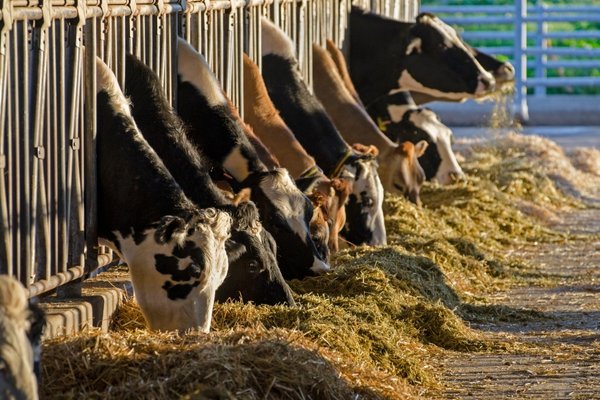
What it does is create a quota system. It’s a barrier to entry. The details are much more nuanced, to be honest. There is access to American dairy. This is a big sticking point for the US. To distill it down, what’s going to happen is, are we going to open up our supply management to the US in a bigger way or not? If we don’t, then I believe that August 1st will come. You’ll see the US apply a 35% tariff on non-CUSMA-exempt products. They’re going to exempt potash, oil, and energy, and they’ll have a reduced tariff on it. The basket of goods will be smaller across the board. That’s going to test the resolve of this new government.
Canadian dairy, in particular, is a part of our identity. We’re going to answer that question of whether it is a part of our identity going forward. I don’t know the answer, but I know that it’s a hot-button topic here. You’re going to balance your auto industry against dairy, energy, and so many other things. We will get through it. In the end, we’re going to have to look forward and develop more projects here. I still believe there’s a lot more in common and a lot more to do together once we get past this. I’m an eternal optimist.
God bless you for that. I have to say, though, that this experience has driven home the idea for me that the default position of a lot of people is big-time cynicism, or at least skepticism, and needless to say, confusion. We keep seeing it month after month with the Fastener Distributor Index reports that we get in. We watch those surveys come in. The next one will be pretty soon.
The Adverse Impact Of US Reciprocal Tariffs To Canada
Let me set this up a little bit closer, too. We’re recording during the week of July 28th, 2025. What’s happening is there’s an August 1st deadline. This is one of those deadlines that they set, and everybody then uses it as a big benchmark. It’s a dramatic showdown, possibly. As of July 10th, the 35% “reciprocal tariffs” that the US slapped on you guys were met with some other tariffs. The negotiating is set to reach a point of agreement on August 1st, 2025, if they can do that. That’s what you were referring to a minute ago.
You’re right. There is a lot of confusion. There are two points I’ll make, 1 on the August 1st deadline and 1 about these deals. Prior to us speaking, the EU has a deal, but the deal has not been signed yet. There are details within it. Let’s be honest. For fastener people, what we care about more than the country of origin tariffs is the steel and aluminum derivatives.
If there’s a way to say there’s a quota established on historical levels with treaty countries, like Europe, Canada, and whatnot, you can bring in so many millions or however many millions of tons of steel based on historical use. That’ll come in at 0% tariff, and then we’re going to have a graduated scale of tariffs where you go over, and it is however many percent that you want to charge. That’s something that would provide some stability and confidence to the market because then, you can plan around it. The devil is in the details.
I’m fairly harsh on the government we’ve had. Try to take your time. If you can get those details worked out ahead of time, maybe it’s going to be the right path forward. What’s the silver lining in all of this? There’s confusion, stress, frustration, and cynicism. Let me be the first to say that I am frustrated by the tariffs. I don’t understand how we’ve come to apply them in this way. I find that we don’t have enough production domestically. We are a company that’s trying to do more domestically in the US, but there’s the reality of how much steel can be produced and parts to be made. Customers still need to build.
I do think there’s a way forward. The silver lining in all of this is, if you had told me in January that we’d be here, I’d say, “We’re hard pressed. How do we go forward?” What’s happened is, since then, I’ve always been in the US. We go to these trade shows. We saw each other in Nashville. People are still positive. Business is still happening. Good companies are still finding a way forward. When you go home, at the end of the day, your family is still there. The things you value are still there. The relationships you value are still there. Those things don’t change.
If you talk to guys who have been in business for 50 years, they say, “I’ve been through this. I’ve been through that. I’ve been through this terrible thing that we never thought we’d get through, and here we are on the other side.” I still believe that’ll be the case here. Good companies and solid companies run by good and passionate people with a vision are going to find solutions. We’re going to come out the other side. This is one of those things that we’ll look back and go, “We got some gray hairs,” but we’ll be sitting down, having a Kentucky bourbon one day. It’ll be water under the bridge.
Good companies run by good people are the ones that will come out the other side of the negative impact of US tariffs. Share on XHow J. Lanfranco Handles Prices South Of The Border
How did J.Lanfranco approach pricing? I know you did a lot of preloading South of the border to cut all this off. How has that strategy worked, and then how’d you handle pricing?
The strategy worked out well until the end of June. We had a six-month runway, or we were planning until the end of June last time. We hit that. We did frontload a lot of inventory where we could get US material, and we did. This is where I do see silver linings. We have customers who still need parts and customers who reacted well to that, so revenues were strong.
As this has continued longer, what we saw was that customers became more worried, so they started to take on more inventory, which depleted us sooner than we anticipated. You’ve had to replenish inventory, and you’ve had to replenish with it being affected by tariffs. Initially, at the end of June 2025, we had to revise our tariff surcharge. Like a lot of companies, we’re not passing on the full tariffs to customers. Our strategy has been to find a way to share it where we can and help them out a little bit. It’s been received well. As this has continued, eventually, all customers have experienced a tariff surcharge. It’s becoming a more accepted reality.
Less pushback?
Less pushback. The big challenge for manufacturers is that as these deadlines keep getting announced and pushed, people are unsure of what the landscape will be. Like everyone, we’ve had an increase in spot buys. It’s like, “There’s a lot of spot buys. I don’t know what’s going to happen. I finally need parts. I’ll take them.” The idea of these pre-booked orders or blanket orders eighteen months out or whatnot is taking a hit. It makes it tougher in terms of committing to material.
We’re loading up on material. I look at it in the sense that our company has been in business for 50 years, even if tariffs last 8 months to 1 year. When I say tariffs lasting, I’m talking about these increased levels where we’ve got to pay them because we haven’t found a way to either onshore all of the products or the products we need to.
Other things that we’re looking at that we don’t have answers to, because these trade agreements are not hammered out, are what if we were to get US steel? We’ve got a big factory in Europe. What if we get US steel? Are the Europeans going to tariff this US steel coming in? If they do, we’re not helping anybody. Let’s say it takes us eighteen months for the dust to settle. Eighteen months in a 50-year company history is a blip. We continue.
To answer your question, how are we handling the tariffs and pricing? We’re being transparent with customers. We’re communicating weekly with them. We’re sharing the pain with them. Revenue has been strong for us. We expect it’ll be a solid year in terms of revenue. The bottom line, for sure, is going to take a hit because tariffs are biting into that.
Stick with your customers. We all do it in different ways. You can share in some tariff pain with your customers if need be. Sometimes, you get a customer and have a machine that breaks, or the mill is late on a delivery. What do you do? You say, “We’re running an extra shift. We’re going to pay a cut in fee at the heat treat. We’re going to air freight something in.” That costs you money, but you do it to maintain and support your customers.
It’s taking on a different form, but at the end of the day, it’s how you support customers and how you work with them in a transparent, honest way. If the companies that are doing this were finding a way through, we are going to come out on the other side. Most importantly, our customers will come out on the other side. I take the emotion out of it.
At the end of the day, Trump is going to represent the US. Carney is going to represent Canada. Ursula has to represent the EU. Take those people aside. If I come down and see you at your homestead, I’m as happy to shake your hand and have a whiskey with you as I would anybody else. We’re all trying to take care of our families, go to work every day, and, hopefully, take care of our communities.
I still believe in that. I still believe that those are the circumstances that we’re presented with. It’s up to us to hold the line and not devolve into always being cynical, pointing the finger, and getting angry. We can’t change what these guys are doing at the top. Keep grinding away. Keep your legs moving. Keep your head up. Keep skating.
In today’s unpredictable market, it is up to us to hold the line and avoid devolving into cynicism and finger-pointing. Share on XFinding A Way To Work Together
That’s what you do. Anyone who knows you knows you’re always the magnanimous voice out there, and that’s continuing. With the average Canadian in the street who is participating in these booze protests, is that still going on, or did they go back to their regular schedule?
A lot of the air came out of that balloon. People who are very excited to say, “Elbows up. We’re going to do this. We’re going to do that,” are people who are far away from the front line. I’m someone who’s not happy with tariffs and the overall tone, but that’s a negotiation happening on a much higher level. The average Canadian will start to realize. Eventually, this will affect Americans, too. People on the ground will feel this. They’re negotiating at a high level.
At the end of the day, we’ve got to find a way to work together. We’ve got layoffs happening. It’s hurting people. You can be a proud Canadian, and you can be opposed to what’s happening. We have to be very careful about getting too excited about getting into a prolonged fight or argument because nobody wins. While you’re getting excited and thinking you’re going to show somebody something, there’s maybe somebody who’s lost their job. There’s somebody suffering. There are real people experiencing real hurt. That’s what gets lost. People are starting to realize that. The other thing that people are starting to realize is that we may be our own worst enemy in this country because we’ve got tons of projects to do, and we can’t get out of our own way.
What’s an example of that? What are you speaking of?
We’ve got energy projects that we can realize for both natural gas and oil. We can also look at energy corridors. You talk about housing. Housing is a big driver of the Canadian economy, like the US. We have a housing crisis. It takes two and a half years to get permits to start building homes in Canada. We could fast-track home-building in this country. For instance, with the EU, one of the cornerstones of this overall agreement or the broad strokes is that Europe says it will buy $700 billion in energy from the US. A lot of it will be natural gas. A few years ago, Canada proudly said there was no business case for natural gas, and we have the fourth-largest reserve.
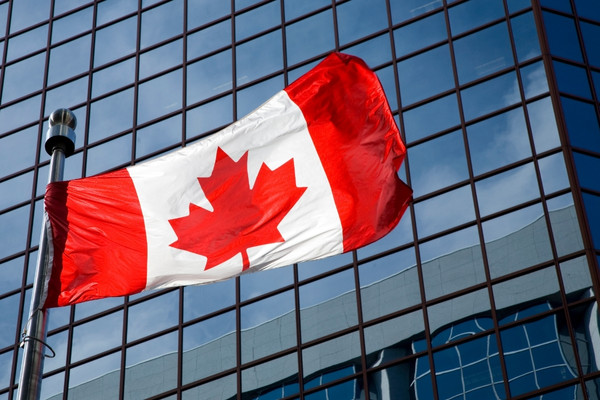
We could go on with a litany of these.
There are things we can do.
The thing is, this is why the widespread cynicism is out there. We have it over here, too, and all over Europe. People don’t understand why the obvious things that should be done or the things that should stop happening aren’t taken care of. There’s no good reason for it. That’s the world we live in. We could go on with that. We wanted to get an update from you, and you gave it to us.
You poked me there and got me all excited. We do quite a bit with Canadian energy, and we’d love to see more. We need it. The world needs it. We’re going to find a way, and I believe that. When it happens, I’ll be so happy when Kentucky Bourbon is back on the shelf up here.
Episode Wrap-Up And Closing Words
It’s a good thing you make frequent trips down here. I know one of them is going to be the Vegas show in September. Are you coming down to Chicago in August?
I won’t make it for the same reason as the Highland Games, unfortunately. In terms of news for us, I forgot to mention, but we’re happy. We got Rick Rudolph Associates. They’re starting to rep us. I think they’ll be at that show. We’re happy to be working with Rick, his team, and his son, Morgan.
Is Lisa coming down?
We’ve got her triple-booked. We have a new general manager who has started. This guy is realizing how much we move and travel. You guys will see him. He’ll be in Vegas. It’ll be his first show with us. He’s realizing that we’re constantly in motion. We don’t stop. There’s a lot of stuff going on here. There are lots of lock nuts and specialty products moving. The rest of it is I go home every day, my chickens are waiting for me, there’s cold beer in the fridge, and there’s something to eat, so I’m a happy guy.
I love that. That’s another thing. I didn’t realize you’re a chicken guy. What are you running?
I’ve got a mix. I got an Azure because they wanted some blue eggs. I’ve got an Orpington, which is a big one. I don’t know if they’re called Sussex. They have gray, speckled hands. It’s an English breed. I’ve got a couple of them. I’ve got Noirans, which are nicely colored. We got a mixed flock.
You’re running a petting zoo over there.
I’ve got a mobile coop. I move it around every couple of days. The great joy is getting up in the morning and going for a cold dip in the pool. The chickens are out with me. We’re having coffee, talking, and solving the world’s problems. I get them rounded up in the coop and then head off to the office. I come home at the end of the day, throw some hammers and some cabers, and then hang out with the chickens again.
That’s a beautiful thing.
I do a little bit of fishing, but we’ll talk about fishing next time. We’ve got a lot to talk about there, but there’s only so much time in a day.
We always do. You’re with J.Lanfranco. Everybody knows that. Thanks again for being here. I’ll see you in Vegas.
I’ll see you there. Take care, everybody.

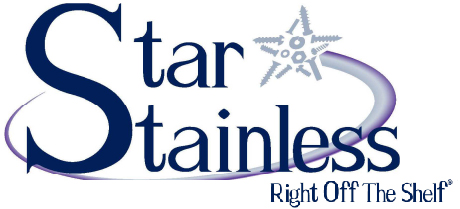
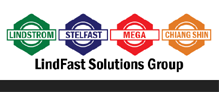
![[GC2610] Solution_FCH Banner_[220x100] copy](https://news.fastenersclearinghouse.com/wp-content/uploads/2025/09/banner_solutionind.jpg)

